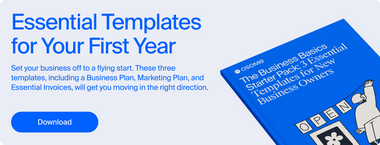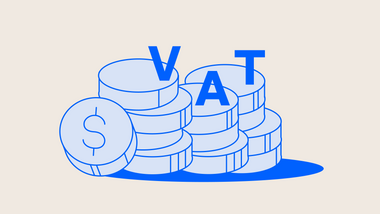2023 Tax Deadlines in UK You Need To Know About
No one wants to miss any of the UK tax deadlines. It usually means an immediate fine and can put you in hot water with His Majesty’s Revenue and Customs (HMRC). But it can be easy to miss one, because there are quite a few UK tax year dates you need to be aware of.

No one wants to miss any of the UK tax deadlines. It usually means an immediate fine and can put you in hot water with His Majesty’s Revenue and Customs (HMRC). But it can be easy to miss one, because there are quite a few UK tax year dates you need to be aware of.
At Osome we see it all the time with small business owners and sole traders. They’re busy with the million and one other business running priorities, and suddenly, they’re facing a fine for missing a tax deadline. And HMRC very rarely recall fines once they’ve issued them. Even if the excuse is legitimate, they’ll always point out that ignorance isn’t an excuse, and the dates are set long in advance.
So, what are the tax year dates? In this article, we’ll look at the main 15 deadlines in 2023, with a brief explanation so you can see if they apply to you. Why not save yourself some hassle and download the key tax dates straight to your calendar?

January Tax Dates To Keep in Mind
31 January
Payment deadline of Capital Gains Tax for sole traders and partnerships
(Download for Google / Outlook)
You need to pay Capital Gains Tax if you’re a sole trader, or in a business partnership and you sell all or part of a business asset for a profit. On the other hand, Registered Limited Liability Partnerships and Companies pay corporation tax on profits from selling their assets. The most common business assets this applies to are:
- Land and buildings;
- Fixtures and fittings;
- Plant and machinery;
- Shares;
- Registered trademarks;
- Your business’s reputation.
First tax payment deadline for sole traders
(Download for Google / Outlook)
This is the date you need to make your first of two tax payments for the year. You need to have filed your online tax return by 31 January too. Don’t leave it until 31 January—file it early— just in case something happens at the last minute. It’s for the 2021/22 tax period, which ended on the 5th of April, so there’s been plenty of time to get this sorted.
Balance for any tax 2021/22 for sole traders
(Download for Google / Outlook)
Any tax that’s outstanding from the previous tax year, 2021/22, also has to be paid by the end of January. But it’s not always more tax to pay, if you overpaid in that tax year this will be balanced with you via a rebate.
What About April?
1 April
Corporation tax to increase
(Download for Google / Outlook)
From 1 April 2023, corporation tax will increase from 19% for companies whose profits exceed £50,000, to a maximum 25% for companies whose profits exceed £250,000. A system of marginal relief will apply between the two rates.
4 April
PAYE annual registration deadline
(Download for Google / Outlook)
Pay As You Earn (PAYE) is HMRC’s system to collect income tax and national insurance payments. You have to register for PAYE if you’re an employer and one or more of your employees:
- Get paid £123 or more a week;
- Get expenses and benefits;
- Have another job;
- Get a pension.
You can read more about PAYE here.
5 April
2022/23 tax year ends
(Download for Google / Outlook)
What dates are the UK tax year? 6 April to 5 April of the following year. So 5 April is the last day of the 2022/23 tax year. The tax return deadline for this year, and when you’ll need to make your first payment is January 31st, 2024.
6 April
2023/24 tax year begins
(Download for Google / Outlook)
This is the first day of the 2023/24 tax year. You’ll need to start fresh and keep records from this day forward. The UK tax return deadline is 31 January 2025 for this tax year.
Update employee payroll records for 2023/24 tax year
(Download for Google / Outlook)
HMRC needs an accurate account of your employee payroll records. On the first day of the tax year, you need to make sure your records of the following are accurate:
- What you pay your employees and the deductions you make;
- Reports you make to HMRC;
- Payments you make to HMRC;
- Employee leave and sickness absences;
- Tax code notices;
- Taxable expenses or benefits;
- Payroll Giving Scheme documents, including the agency contract and employee authorisation forms.
19 April
Submit final Full Payment Submission and Employer Payment Summary
(Download for Google / Outlook)
Your Full Payment Submission (FPS) is a form that lets HMRC know an employee's details, pay and deductions. An FPS needs to be sent to HMRC every time you pay your employees.
Your Employer Payment Summary (EPS) is needed if no employees were paid in the reporting period, or if you want to claim any payments or deductions (e.g. employment allowance).
There’s Only One May Day to Remember
31 May
P60 to employees on the payroll
(Download for Google / Outlook)
All employees need to be given their P60 for the 2021/22 tax year. A P60 shows the tax that they’ve paid on their salary and is used in the following ways:
- To claim back overpaid tax;
- To apply for tax credits;
- As proof of income if you apply for a loan or mortgage.
What’s Happens in July?
6 July
P11D Deadline
(Download for Google / Outlook)
If some of your employees get “benefits in kind”, such as company cars or interest-free loans, you’ll need to submit P11Ds for them to HMRC.
19 July
Payment of Class 1A NICs by post
(Download for Google / Outlook)
Most benefits you give your employees need Class 1A National Insurance Contributions (NICs) to be paid. Class 1A NICs also need to be paid on non-contractual lump sum payments, such as redundancy payments that are over £30,000. The rate in the 2022/23 tax year was 14.53%.
22 July
Payment of Class 1A NICs electronically
(Download for Google / Outlook)
If you’re going to pay your Class 1A NIC online, you have an extra 3 days to submit it.
31 July
Second tax payment deadline for sole traders
(Download for Google / Outlook)
You made your first payment by 31 January, so six months later you need to make your second payment for the 2021/22 tax year.
There Are a Couple of Key Dates in October
5 October
Notify HMRC of all taxable income sources and NICs for the 2022/23 tax year
(Download for Google / Outlook)
All sources of income need to be declared for tax purposes, and so that you can make NIC payments. If you started a new source of income, or registered as Sole Trader for the first time in the 2022/23 tax year, you need to notify HMRC by this date so they can send you a tax return to complete.
31 October
Paper tax Return for 2022/23 self-assessment due
(Download for Google / Outlook)
HMRC would rather you file your tax return online, but you still have the option to do your tax return on paper. If you want to go this route you’ll need to post an SA100 form to HMRC so it arrives before this date.
That’s About It
All the dates for the UK tax year that you need to know about. Get these important tax dates in your calendar, set reminders and do whatever you have to do to make sure you don’t miss any of them.
We’ll manage your tax calendar
It’s a lot to remember. If you need any help with your tax return, whether you’re a small business or a sole trader, we’d love to have a chat and see how we can help you.







